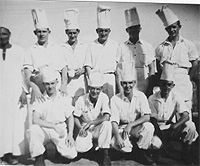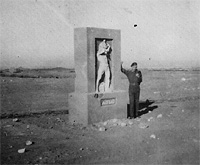
BMH Fayid - Main gate 1950

BMH Fayid - tented accomodation
BMH FAYID - HOSPITAL COOK
As Remembered By John W. Cotton
I arrived at BMH Fayid during July 1950 as Hospital Cook att. RAMC and served there for approx 6 months. My first sight of BMH was a rude awakening – I had pictured a colonial style building with verandas surrounded by palm trees etc. What I got was more or less Nissan hut wards and other buildings that looked like farm sheds. Of course, this did not distract from the good work and care of the patients that was carried out at the hospital. I believe there were approx. 300 patients at this time.
|
BMH Fayid - Main gate 1950 |
BMH Fayid - tented accomodation |
We had a fair number of hospital cooks working in two groups of 24 hours on and 24 hours off duty. One cook was detailed for night duty and I carried out this for a period of four weeks. Duties included preparing a meal for the night duty Nursing Sisters (Q.A.R.A.N.C.) the preparing of vegetables and the slicing of goodness knows how many loaves of bread. On one occasion 3 or 4 lads were brought to the cookhouse at about 2am, having transported some patients in from the desert – I think they were from a Field Ambulance Unit and they certainly enjoyed the meal that I cooked them.
 |
We would go down to the Egyptian village adjacent to the Sweet Water Canal and peruse the local shops that sold the usual leather goods etc. Two things that did stand out in my mind was 1) seeing a little Egyptian boy wearing a German army belt and 2) visiting a shop that was apart from the others and finding it was owned by an Englishman. He told us that he had been in the army but liked Egypt so had settled there. I also remember seeing the Mummy outside the antique shop. It had the upper bindings removed and the postcard stated it was that of a High Priest. I also bought a sea book in the bookshop there and still have it to this day.
|
The Flea |
BMH Fayid from the Flea |
Gebel Geneifa from the Flea |
BMH was one of the closest units to The Flea. One afternoon a companion and I went out and carried out the climb (or scramble). Whilst at the top we met a Royal Signals officer with a small dog. I believe he was C.O. of a Signals Units. When at the top we were alerted by the sound of a large column and from the desert in the west a convoy of half-track self propelled guns appeared – a magnificent sight. On another occasion 3 or 4 of us climbed the escarpment which was at the northern end of Gebel Geneifa. This was more difficult to climb than the flea and I understand that the remains of a British Serviceman had previously been found at the foot of the cliffs after being missing for about a year or so.
 |
 |
 |
We also visited the German POW camp and marvelled at some of the carvings and wall paintings there
Every other week when I was off duty I would stroll down to the MMG Canteen and enjoy the comfort of an armchair, a drink and get homesick reading back copies of Country Life.
I did end up being a patient in the hospital having been struck down by some bug or other which floored me. I then had a spell at BCD to convalesce. About this time there had also been an outbreak of typhoid at an RAF Base affecting quite a few people and I believe even causing a number of deaths.
In January 1951 I was posted to Station Hospital, Suez Garrison and was sorry
to leave BMH Fayid